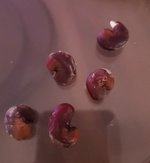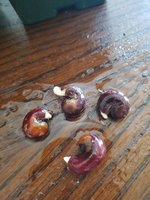About a year and a half ago I started on a quest to grow all 8 Baobab species. So far I've successfully started 7 of the 8 species from seed.
I'm not yet sure who survived the winter, but I have a fair amount of seed left and one more species to go! So, earlier this week I started another round.
My process for germination of Adansonia is:
1) Soak them overnight in hot (not scalding) water. This softens the shell of most species just a little.
2) Then I take a file and file a spot until I can see a speck of the inner seed...not deep enough to damage it, but deep enough that water can get in.
3) Then they soak in more hot water for 24 hours. This is usually enough for the seeds to swell to 2-3 times their original size and for the outer shell to soften enough it can be peeled off.
4) I carefully peel off the hard outer shell.
5) The de-shelled seed is placed inside a damp paper towel for another 24 hours.
6) By this time most seeds will have started elongating their roots. The cotyledons will also be less tightly packed. If I see obvious root elongation, I move them. Otherwise they stay for another 12 hours.
7) Once I see obvious root growth, I move them into 1 liter soda bottles with the top cut off and holes in the bottom for drainage. I use coconut coif seedling mix. I _just_ bury the seeds on their "stomach" with the root tip pointing down.
8) I try to keep the surface of the coif humid without drying out. Usually the seed will sprout in another day or three...if it's been much longer than that and the seedling hasn't stood up, it's likely rotted.
9) Once the cotyledons open, the plant "pauses" to grow a tap root...but after a week or so, the first real leaves should be sprouting. Once the plant makes it this far, things get significantly easier
Anyway, today I'm at step 7 for everyone BUT Suarezensis...the one species I have yet to germinate AND the one I can no longer source seed for AND the one I am running out of
This time, however, it's doing something I have never seen on any other seed. When I went to open up the paper towel, I had to peel it off the seed as it was stuck on a little. The seed itself has what looks like a gel all over it...hopefully that shows up well enough in the picture.

It doesn't wipe off. I've never seen it before on multiple attempts with this or other species. Does anyone have any ideas what it might be?
More importantly...to me anyway ...does the collective knowledge base here have any suggestions on how to get these guys to germinate? I know it's not a typical species for this crowd, but there is a lot of collective horticultural knowledge here! Hopefully someone has some ideas to help me with this stubborn species!
...does the collective knowledge base here have any suggestions on how to get these guys to germinate? I know it's not a typical species for this crowd, but there is a lot of collective horticultural knowledge here! Hopefully someone has some ideas to help me with this stubborn species!
Sadly I'm down to my last few seeds! I'm getting to the point where I'm afraid to try again because once I'm out of seed I'm not sure if I can ever get more. This species is endangered. I do know of a vendor where I can get cuttings, but that's another story for another day! I'd rather grow them all from seed if I can. I certainly don't see the point of continuing to try the same process over and over. The process I have works with high germination rates (>80% for me so far) across the rest of the species so I would have expected it to work on these guys already if it was going to.
I'm running out of ideas to try...help!
I'm not yet sure who survived the winter, but I have a fair amount of seed left and one more species to go! So, earlier this week I started another round.
My process for germination of Adansonia is:
1) Soak them overnight in hot (not scalding) water. This softens the shell of most species just a little.
2) Then I take a file and file a spot until I can see a speck of the inner seed...not deep enough to damage it, but deep enough that water can get in.
3) Then they soak in more hot water for 24 hours. This is usually enough for the seeds to swell to 2-3 times their original size and for the outer shell to soften enough it can be peeled off.
4) I carefully peel off the hard outer shell.
5) The de-shelled seed is placed inside a damp paper towel for another 24 hours.
6) By this time most seeds will have started elongating their roots. The cotyledons will also be less tightly packed. If I see obvious root elongation, I move them. Otherwise they stay for another 12 hours.
7) Once I see obvious root growth, I move them into 1 liter soda bottles with the top cut off and holes in the bottom for drainage. I use coconut coif seedling mix. I _just_ bury the seeds on their "stomach" with the root tip pointing down.
8) I try to keep the surface of the coif humid without drying out. Usually the seed will sprout in another day or three...if it's been much longer than that and the seedling hasn't stood up, it's likely rotted.
9) Once the cotyledons open, the plant "pauses" to grow a tap root...but after a week or so, the first real leaves should be sprouting. Once the plant makes it this far, things get significantly easier
Anyway, today I'm at step 7 for everyone BUT Suarezensis...the one species I have yet to germinate AND the one I can no longer source seed for AND the one I am running out of
This time, however, it's doing something I have never seen on any other seed. When I went to open up the paper towel, I had to peel it off the seed as it was stuck on a little. The seed itself has what looks like a gel all over it...hopefully that shows up well enough in the picture.

It doesn't wipe off. I've never seen it before on multiple attempts with this or other species. Does anyone have any ideas what it might be?
More importantly...to me anyway
Sadly I'm down to my last few seeds! I'm getting to the point where I'm afraid to try again because once I'm out of seed I'm not sure if I can ever get more. This species is endangered. I do know of a vendor where I can get cuttings, but that's another story for another day! I'd rather grow them all from seed if I can. I certainly don't see the point of continuing to try the same process over and over. The process I have works with high germination rates (>80% for me so far) across the rest of the species so I would have expected it to work on these guys already if it was going to.
I'm running out of ideas to try...help!


